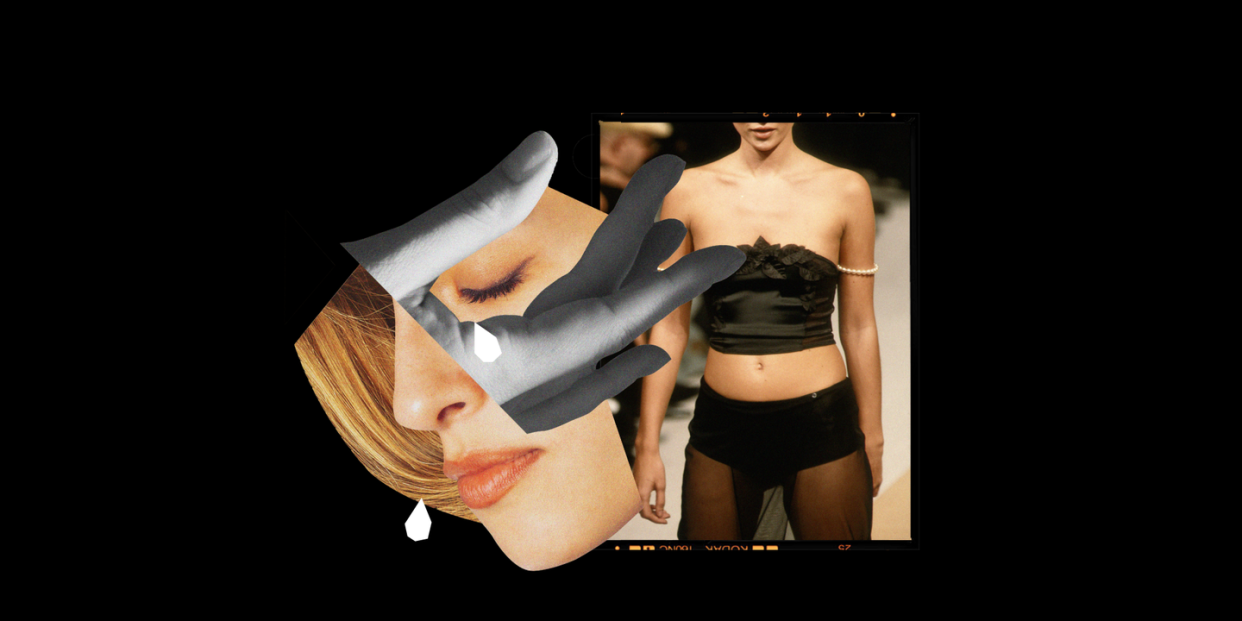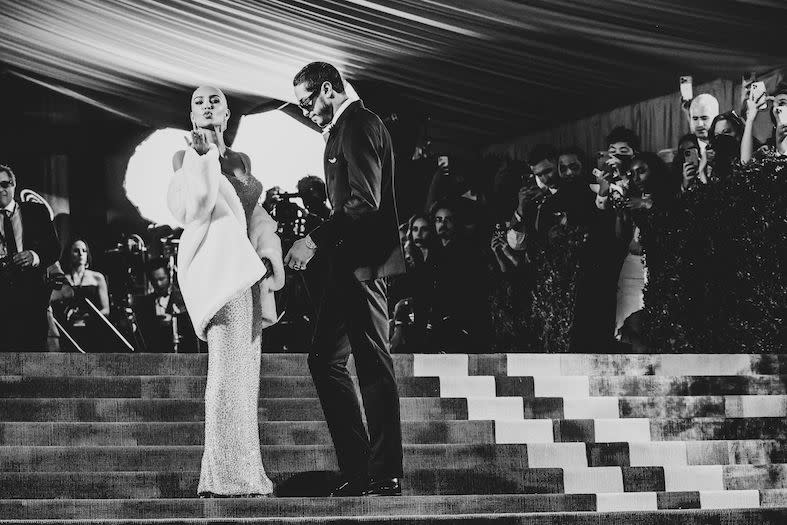"The return of heroin chic should worry all of us - I should know, it led me to an eating disorder"

POV: it’s 2013. Immediately after school, I run to my safe space - my computer. I’m morbidly excited to spend the next few hours cocooned in darkness, bathing in the deep blue glow of the Tumblr homepage. I dart my eyes from left to right, to make sure I’m alone, before typing #thinspo into the search bar. I linger longingly over images of super-slender girls with ‘thigh gaps’ wearing Doc Martens and American Apparel skater skirts, wishing I could look like them.
Around this time, at the age of 14, I started to restrict my eating. For months I followed the same routine; returning home from a gruelling and lonely day at a school, to compare myself to emaciated frames on the internet. My online habits translated into my real-world eating habits too, as I began limiting what I ate. I would add up calories on a sheet of paper each day, beads of sweat dripping from my forehead. When I looked at food, I saw numbers rather than nutrition. I would often avoid eating, a sour, metallic taste lingering on my tongue instead. In the moments that I ‘lost control’ I would punish myself in the only way I knew how - purging. This is what ultimately led me to seek therapy and make steps towards recovery, aided by the invaluable support of my family.
Fast forward to 2022, and TikTok, rather than Tumblr, is the go-to platform for a younger demographic; as of 2020, 24% of UK users were between the ages of 15 and 25. But instead of moving away from the pro-eating disorder content of yesteryear, society seems to be pedalling backwards. The app is churning out trends at the speed of light and the ‘Tumblr girl’ aesthetic, reminiscent of my teenage years, is, ironically, one of them. The #tumblrgirl hashtag has over 298.6 million views on TikTok, with users posting videos portraying the archetypal ‘messy sad girl’ who has a black coffee with a cigarette for breakfast. And whose bones are visible under her skin. Although the hashtags of a decade ago, like ‘thinspo’ are blocked on social apps like TikTok and Instagram (instead redirecting to mental health support services), others have appeared in place to serve similar content.
While this may seem innocent to some (and there’s an argument to be made about freedom of expression and art being personal), this type of content also teeters on the verge of idolising dangerous habits - something that the body positivity, and body neutrality, movement has been working hard to combat over the last couple of years. But, combine the resurgence of Tumblr ideals with the the renaissance of 90s supermodels like Kate Moss (who infamously declared that “nothing tastes as good as skinny feels”), the emergence of aesthetics like ‘balletcore’ and ‘coquette’, which glorify hyper-femininity and romanticise girlish bodies, and the Kardashians debuting (and celebrating) hyper-slimmed down frames; and what are we left with? A thinly-veiled breeding ground for pro-eating disorder content to run rife (again).
And it’s already having an effect. According to new research, the number of under-20s going to hospital for eating disorders in the UK saw a near 50% increase on the year before, and Tom Quinn, Director of External Affairs at Beat, told Cosmopolitan UK that “between April 2021 and March 2022, [Beat] provided 3 times the amount of support sessions in comparison to pre-pandemic levels”.
Inexplicably, some seem to be ushering in this worrying resurgence, too. The New York Post’s recent article, Bye Bye Booty: Heroin Chic is Back, received backlash for perpetuating the notion that women’s bodies are fads, using deeply misogynistic and derogatory language in the process. The article paints ultra-slim supermodels such as Bella Hadid as the blueprint to be emulated, crediting them with “bringing the look back” (including low rise jeans, paired with sharp hip bones). My skin crawled as the New York Post writer described women in an almost fetishising way: as “waifish girls” with “supremely svelte” figures and “skinnies sashaying down the runway”.
She appears to make light of an extremely concerning development, supposedly ignoring how triggering this content could be for many readers. The insensitive rhetoric teleports me right back to 2007, when at the tender age of eight I’d flick through gossip magazines while my mum did the shopping. My eyes would be drawn to the nauseatingly neon ‘hot or not’ spreads that judged female celebrities’ ‘bikini bodies’ with unflinching cruelty. These magazines would circle and scrutinise every crease and curve of a woman’s body, slotting them neatly into one of two categories: celebrated, or shamed.
My teenage years were defined by popular culture’s fickle beauty standards and my perpetual inability to meet them. My fellow Gen Zers will agree that it’s hard to ignore the undeniable hand the Kardashians have in perpetuating these unattainable expectations, too. It’s no coincidence that Brazilian Butt Lift surgeries (BBLs) rose to unprecedented popularity in 2015, in the wake of Kim Kardashian’s infamous Paper Magazine cover shoot, which glorified “the vicissitudes of her ample curves” with Shakespearean lyricism.

Though the Kardashians vehemently deny having undergone the procedure themselves, their impossibly tiny waists and voluptuous behinds were no doubt the impetus that spurred on countless women who decided to get a BBL themselves. In 2015, a BBL was performed every 30 minutes in the US, despite the notoriously high mortality rate of 1 in every 3,000 surgeries.
Change in the body of a Kardashian rarely goes unnoticed. Ahead of this year’s Met Gala, Kim embarked on a strict weight-loss regime to fit into Marilyn Monroe’s crystal-encrusted ‘Happy Birthday’ dress. Speaking on the red carpet, Kim went into detail about the steps she took to lose the weight in such a short amount of time. She spoke proudly, with a blissful smile on her face, as if it was an achievement.
It’s hard to articulate just how damaging this kind of blasé attitude towards weight loss can be. Tom Quinn from Beat explains that although “not every person with an eating disorder will have negative thoughts about their body […] idealising thinner bodies can make eating disorder behaviours worse for people who are already unwell”. Body image is a triggering topic for many, with an estimated 1.25 million people in the UK suffering with eating disorders.
Whilst the Kardashians bear some responsibility for perpetuating body trends, they’re not entirely to blame. Beauty standards have existed throughout history. In the 1800s, women would wear ‘bustles’ to exaggerate their posterior, eerily foreshadowing the BBL body of the 2010s. Meanwhile, having a slender frame was fashionable both in the ‘flapper’ era of the 20s and during the reign of Twiggy in the 60s. Trends have come and gone with the arrival of each new decade, ebbing and flowing like the tide of the sea.
But, thankfully, something feels different this time around. It’s gradually dawning on women across the globe that body trends are exactly that: trends. Which, when you actually think about it, is downright ridiculous - it’s nonsensical that we’ve been conditioned to label our bodies as such a thing. Our bodies are the vessels that carry us through life, and they deserve to be celebrated. And I’m proud to say that after years of suffering with body dysmorphia myself, this is something I’ve come to realise, too. Society is moving on, and so am I.
Nowadays, rather than rushing home to absorb hours of slender bodies online, I’m more likely to be found actively choosing content that makes me feel good about myself, and my body. My Instagram feed no longer fuels my insecurities, due in part to my decision to follow body positivity influencers like Nelly London and Danae Mercer, who are beacons of light shining through the cracks of the warped world of social media. I engage with fashion shows that inspire me, that showcase models of all shapes and sizes; a far cry from the runway of the 90s.
Sure, society still has a lot of work to do. There is a noticeable absence of diverse body representation in high fashion, in particular, that needs addressing. But regardless of whether or not some brands, or high-profile individuals, are working hard to “bring back” the “heroin chic” aesthetic, ultimately we all have a choice as to whether or not we engage with it. Instead of breathing more air into the idea that ‘thin is in’, let’s remember that.
If you’re worried about your own or someone else’s health, you can contact Beat, the UK’s eating disorder charity, 365 days a year on 0808 801 0677 or via the website
You Might Also Like

